Abstract
Human resources (HR) are typically seen as the most important asset of an organization for a good reason. Once staff members are motivated, enthusiastic, and eager to engage with the objectives of a company, significant improvements in quality and efficacy of their performance can be attained. Thus, the understanding of how HR objectives can be implemented in companies will help to build an effective way of managing HR accordingly. This report will consider some of the key methods of implementing and improving the HR function within an organization.
Introduction
For a company to function effectively in the environment of the global economy and increase its competitive advantage, particularly close attention must be paid to the strategies selected for managing its HR function. Depending on the approach that a company may choose to manage its staff members, it may lead to a tremendous success or, on the contrary, set the stage for an untimely and irreversible demise. To bring an effective HR strategy into existence, an organization must be aware of the key HR functions that must be deployed in the corporate setting. In the modern organizational setting, the key HR functions can be reduced to eight major ones (see Fig. 1 below).

As a rule, the organizational objectives that have to align with the HR function are classified into organizational, functional, personal, and societal ones. Thus, the HR function is responsible for the enhancement of a company’s performance by increasing staff members’ motivation and, therefore, their potential as members of the company (Banfield et al., 2018).
The recruiting aspect of the HR function lies at the heart of its ability to meet the organizational objectives, primarily, the ones associated with the need to deliver the performance of the expected quality and rate. During the recruitment, an HR manager has to utilize the tools and techniques that will allow them to identify the people that possess the needed array of skills and fit a specific job position best (see Fig. 2).
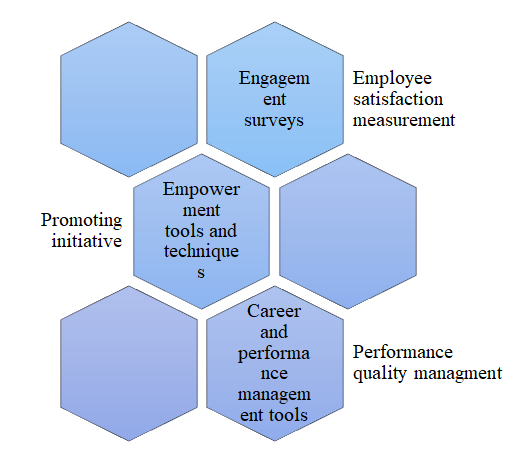
The motivational aspect is intrinsically connected to the issue of staff members’ professional development and the provision of innovative and useful options for gaining new skills and essential knowledge. The specified component of the HR function is also tied to the organizational goals of increasing a company’s performance and its competitive advantage. Furthermore, the extent of employees’ motivation is also highly dependent on the leadership strategy that a manager chooses to use in the organizational setting.
Traditionally, the Transformational Leadership approach is deemed as the one that increases employees’ motivation levels to the maximum due to the presence of a clear example, the appeal to employees’ personal needs and goals, and the inclusion of the philosophy based on professional development and growth (Banfield et al., 2018) (see Fig. 3).
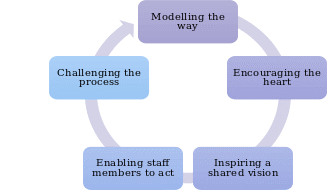
In conjunction with the latter, the incorporation of effective training techniques should be regarded as a critical aspect of the HR function within an organization. As an HR manager, it is one’s duty to ensure that the level of employees’ competencies and skills corresponds to the requirements and criteria of quality set by the organization and the market in which it operates (Banfield et al., 2018). Therefore, appropriate training techniques must be introduced into the organizational setting with the help of the HR function.
In addition, the HR function is inseparably tied to the objective of research, which is typically deemed as the vehicle for the organization’s development and the tool for building its competitive advantage in the environment of a particular industry. In turn, a correct selection of the HR strategy allows an HR manager to ensure that a company evolves and develops the required amount of potential for retaining its ability to compete in the target market.
When considering closer the examples of organizational goals and expectations that the HR function is expected to meet, one might want to examine the tasks of recruitment, retention, and talent management in greater detail. Ensuring that a company recruits competent staff members that are willing to contribute to its development is essential. In addition, it is necessary to make sure that employees remain loyal and stay with the company, which will require profound, inspiring leadership and incentives. Finally, it is the job of the HR department to incite professional growth in employees and encourage them to explore their talents in the organizational setting.
The evolution of recruitment, retention, and talent management over time has also been quite remarkable. Specifically, the focus on people as the main asset of an organization, as well as the willingness to invest in human capital, can be deemed as the most prominent developments.
As a result, the HR function had to adjust, altering the existing set of strategies and techniques and incorporating new ones. Although the integration of innovative technology might be the first aspect of the observed change that stands out to side viewers most, it was the promotion of the acceptance of the change that has demanded the most effort.
In the context of an organization, change cannot be considered a separate entity but, instead, must be envisioned as a part of a company’s unending cycle. Therefore, a clear understanding of the key theories of change is needed to perform the HR function adequately and foster the environment that is highly supportive of innovation-driven culture. Consequently, an HR manager must be aware of major theories of change that can be implemented in the organizational setting.
Although new models of organizational change emerge quite often, four key frameworks have been established as the accepted theories of organizational change. These are Lewin’s Change Management Model, Kotter’s change management theory, McKinsey 7 S Model, and the ADKAR Theory (Banfield et al., 2018).
Each of the described theories has a well-established place in the current framework of business management. It is worth highlighting that none of the theories should be seen as ultimately superior since each may be applicable to a specific organizational setting depending on the circumstance and the characteristics of a company.
The theories listed above are implemented by isolating the key goals that a company strives to achieve, evaluating the current organizational environment to isolate key concerns, assess the HR strategies used to manage the specified concerns, and locate the key milestones for change. Afterward, the strategy for implementing change is identified and introduced into the corporate context, changing staff members’ performance and behaviors, as well as attitudes, if needed.
Focusing specifically on the theories that are used most commonly in the corporate environment, one may single out the ones by Kotter and McKinsey as the universal approaches that are most frequently used in the present-day organizational setting. Kotter’s 8-Step Model suggests the following stages of change: creating urgency, developing a team, creating a vision, communicating it, empowering staff members for action, creating short-term wins as milestones, follow up, and ensure that changes are institutionalized in the company (Banfield et al., 2018) (see Fig. 4).
McKinsey’s approach to change management represents slightly smaller number of components and represents them as concepts instead of a call for action, as Kotter’s Model does. McKinsey’s Model includes the structure, systems, style, staff, skills, strategy, and shared values as the central concept (Banfield et al., 2018). The proposed change management model allows controlling change by incorporating it into the organizational value system.
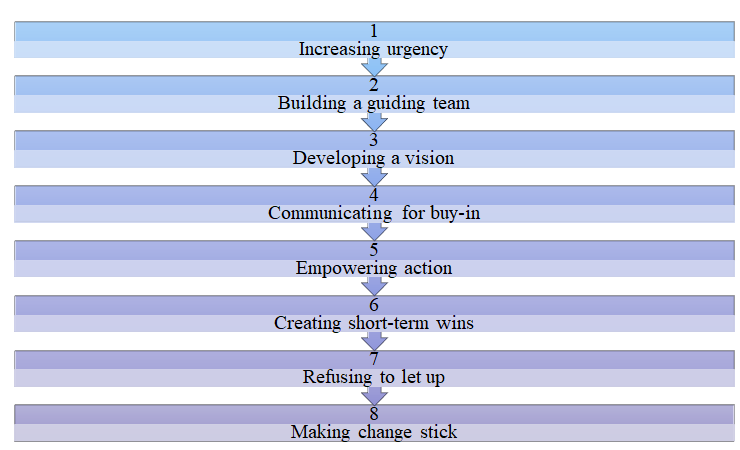
Applying the models of change described above to the organizational context, one will realize that both frameworks function quite well when applied to appropriate contexts. Namely, Kotter’s 8-Step Model is perfect for changing the organizational philosophy and introducing new value, which is critical when transitioning to a new environment (Banfield et al., 2018).
Namely, the AT&T’s example indicates that the shift toward a new model of collaboration needs to occur as a natural progression from the current disjointed framework to a more cohesive strategy. However, McKinsey’s Model also serves its function of institutionalizing and controlling change by unifying the organizational strategies under a single philosophy (see Fig. 5).
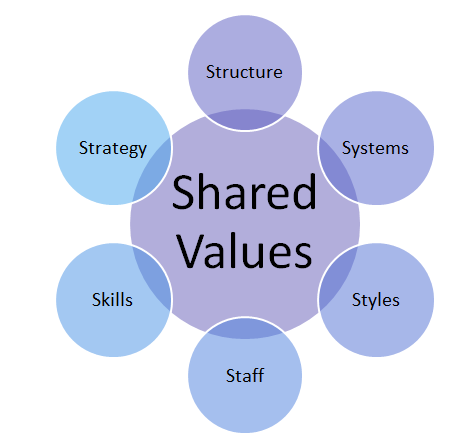
The need to increase the extent of employee motivation, engagement, and loyalty could be an example of change in an organization that could require the application of the two models mentioned above. The specified change is rather difficult to perform since a leader is likely to face resistance toward the described change among staff members. Following McKinsey’s Model, one will have to restructure the corporate values in the way that allows focusing on the needs of all stakeholders, including employees.
The related systems changes will imply integrating a new approach toward allocating financial resources to provide staff members with a greater range of benefits and incentives. The style aspect of McKinsey’s Model, in turn, will require a transfer to a better leadership framework, which, in the described case, can be represented by Transformational Leadership (Banfield et al., 2018). The focus on staff will also require updating the current talent management framework, thus, encouraging employees to develop new skills. Finally, a change in the strategy for managing organizational relationships will help to tie all of the described changes together, connecting them to the common framework of shared values.
Another example of organizational change that a company is likely to need drastically in the realm of the present-day business setting, the increase in quality will demand a well-developed change management model. Specifically, a company could set a drop in the number of defects per batch of products as a goal to be attained as a result of change. Applying Kotter’s 8-Step Model, one will need a set of SMART goals (see Fig. 6 below).
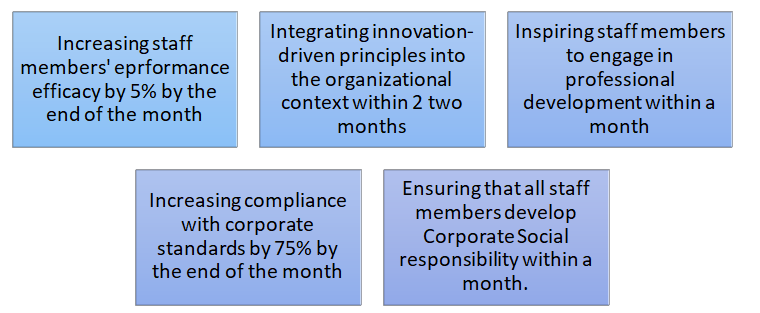
Establishing the specified goals will have to follow an agenda created by the leader. The specified steps will correspond to stages 1-3 of Kotter’s model, namely, establishing the urgency of the issue, creating a team, and offering a vision. In turn, the tasks of creating a buy-in and communicating a vision can be accomplished by addressing the problem of resistance to change with incentives and setting a number of criteria for quality with which employees will have to comply during their performance.
In turn, as a part of building on the change, one may need to consider the tools for promoting corporate social responsibility to prepare the platform for the organizational philosophy. The specified step will also help to transfer to the eighth stage of Kotter’s model, namely, cementing the changes made to the company’s performance standards.
It is impossible to underestimate the importance of ethic and justice in business. Although justice and fairness as components of business interactions are often seen as naïve representations of business relationships, they, in fact, lie at the heart of successful management of an organization.
The specified principle applies to the HR function as well, implying that, as an HR manager, one has to align one’s decision-making with the ethical standards and principles based on which a company is run. In addition, it is the responsibility of an HR manager to address problems in the ethical framework established within a company and create a safe environment in which staff members can collaborate and work most productively (see Fig. 7).
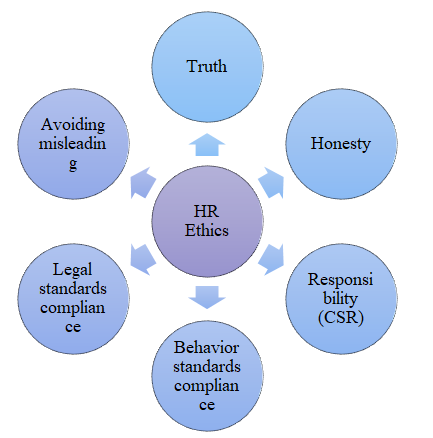
The focus on justice when addressing HRM issues is particularly important since it contributes to building the corporate climate in which employees are inclined to accept corporate values, approach their workplace takes responsibly, and focus on improving their performance, as well as contributing to the company’s progress. In other words, an HRM policy based on fairness, justice, and stakeholder-oriented ethics will lead to an increase in the levels of motivation in the workplace environment (Banfield et al., 2018). Thus, the contribution of an HR manager to the development of corporate ethics and its support is quite vast.
Along with motivation rates, employees’ loyalty is likely to grow. Studies show that the organizations in which the HR function is built on the rigid principles of fairness and corporate ethics lead to particularly impressive outcomes (Banfield et al., 2018). The propensity toward fairness and justice during the process of selection of candidates for the job is especially appreciated, as the research says.
Namely, Konradt et al. (2017, p. 8) state that “Fair selection procedures should serve as important signals to applicants regarding how they can expect to be treated after they are hired.” As a result, with the adoption of the concepts of fairness and justice, an HR manager can launch trust-based relationships with staff members and the gradual development of loyalty in them from the very beginning of their integration into the organizational environment (see Fig. 8).

In addition to the recruitment and selection stages of implementing the HR function, an HR manager also needs to act fairly and professionally in order to ensure that employees are motivated and inclined to trust their company. The rise in motivation levels among staff members inspired by the focus on fairness, honesty, and justice in a company is also likely to lead to the willingness to develop new professional skills and contribute to a company’s progress. Thus, the promotion of fairness and justice creates premises for introducing training options and invites employees to try their opportunities in building a new and improved skill set (see Fig. 9).
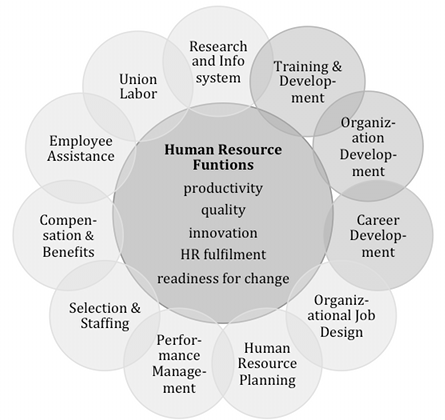
The HR function depends on an array of external and internal factors, the size of a company being an impotent example of the latter. Based on the scale of a company and its ambitions, different HRM strategies need to be deployed in the organizational environment. There are several HRM models that one needs to take into consideration when determining g the tools for meaning staff members in the organizational context. Specifically, four primary HRM models are traditionally isolated as the foundational principles for managing staff; these are the Fombrun, the Harvard, the Guest, and the Warwick models.
Each represents a unique approach toward handling employee-related issues in the organizational context. However, all models seem to agree upon the fact that keeping employees’ motivation rates high allows an organization to thrive and creates the setting where incremental innovations and continual quality improvement can be achieved.
Based on which model is selected, the HR function may imply the focus on individual well-being (Fomburn) (see Fig. 10), the search for the connection between the key stakeholders (the Harvard Model) (see Fig. 11), alignment of HRM strategies with the corporate perspective (Guest) (see Fig. 12), and the focus on internal and external factors (Warwick) (see Fig. 13). Thus, depending on the choice of the model, the HR function may be skewed toward any of the concepts above.

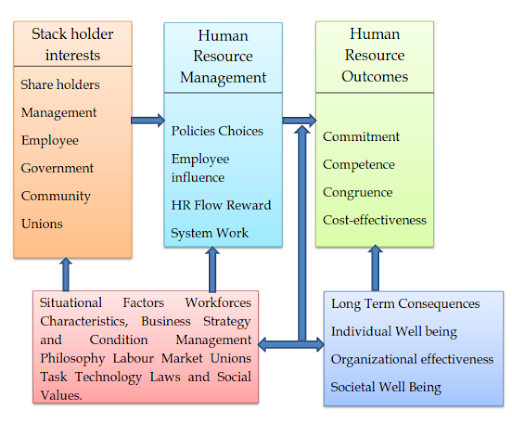
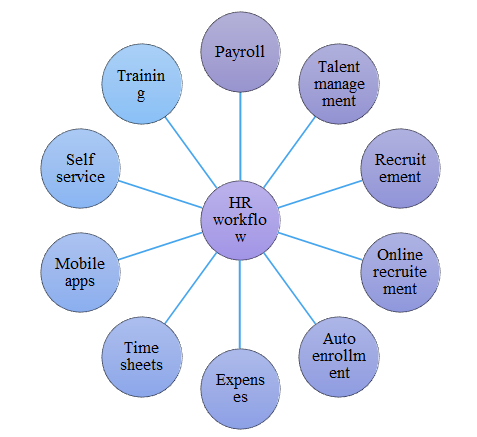

To understand how the HR function varies depending on the size of a company, one may need to compare its implementation in SMEs and large corporations. First and most obvious, the size of a company defines the HR metrics, which means that a company of a smaller size will have a different metrics than a larger one. In a smaller company, the HR function is quite basic, whereas in larger companies, it grows and evolves to gain additional complexity.
For instance, in a local firm, the HR function is likely to be linear and be based on a single and homogenous approach, such as the promotion of training opportunities for staff members in a minor retail shop. In larger organizations such as AT&T, the HR function will have to focus on balancing the issues of diversity and addressing conflicts that may occur when the interests of a diverse group collide.
Moreover, unlike in SMEs such as a local coffee shop, where the connection between the HR function and the company’s objectives is clear and easy to maintain, larger organizations such as AT&T may suffer from the lack of coherence between their objectives and their HR function (Banfield et al., 2018).
Likewise, the HR function depends to a considerable extent on the sector in which it is deployed. For example, in a food industry, the focus is likely to remain on quality and time management, whereas in the context of telecommunication, the importance of enhancing communication and collaboration among staff members is likely to be prioritized over other elements of the HR function.
Using the HR Business Partner Approach
The manner in which the HR manager decides to approach corporate objectives hinges on a vast number of factors, some of which may include the size of an organization, the industry in which it operates, the specifics of the local labor market, the corporate goals to be achieved, and many more (Banfield et al., 2018). Among the existing approaches toward delivering HR objectives in the corporate context, one might want to pay especially close attention to the HR Business Partner Approach.
Based on the Ulrich Model of HR Roles, the HR business partner can be defined as a group of people who organize to use their experience and authority for establishing standards and criteria for managing HR in the workplace (Banfield et al., 2018). In addition, the HR business partners are expected to ensure that the strategy chosen for managing the HR and their needs aligns with the corporate goals and objectives.
The main advantage that the HR Business Partner Approach provides is the opportunity to see organizational processes as a single big picture, thus contributing to effective strategic thinking that will lead to improvements across the company. Arguably, the proposed framework has its inherent flaws, which makes its application quite difficult in some settings.
For example, without the needed level of competency and amount of experience, the HR Business Partners may fail to make the decisions that will ultimately benefit the company and its staff. In addition, the differences in the strategic planning caused by the incongruences between HR Business Partner approaches and the goals of a specific organization may cause problems in implementing the proposed model and, ultimately, result in a failure.
Using Outsourcing
Outsourcing is another tool that can be used to increase the efficacy of an HR strategy in the context of a company. In HR, outsourcing takes the form of subcontract, according to which HR-related functions are assigned to an outside supplier of the HR-related services. Therefore, HR outsourcing provides an opportunity to exert better control over specific activities, such as HR development, as well as the general flow of the HR function. The benefits of HR outsourcing are quite evident; specifically, it gives an opportunity to use the knowledge and experience of an outside supplier of HR, thus setting premises for knowledge sharing and the development of new competencies in staff members.
The effectiveness of responses to employees’ needs, as well as the opportunity to replace the internal HR unction, should also be listed as essential advantages that the outsourcing strategy provides. Nevertheless, one will still have to focus on some of the weaknesses by which outsourcing can be characterized, such as the possibility of legal disputes between the company providing outsourcing services and the organization receiving them.
The described problem may arise in the situations in which the details of collaboration between the supplier of outsourcing services and the buyer company have not agreed upon certain details of the transaction, as well as the specifics of the HR function. The described issue can be addressed by using the shared outsourced HR administration, which will allow managing emergent threats accordingly.
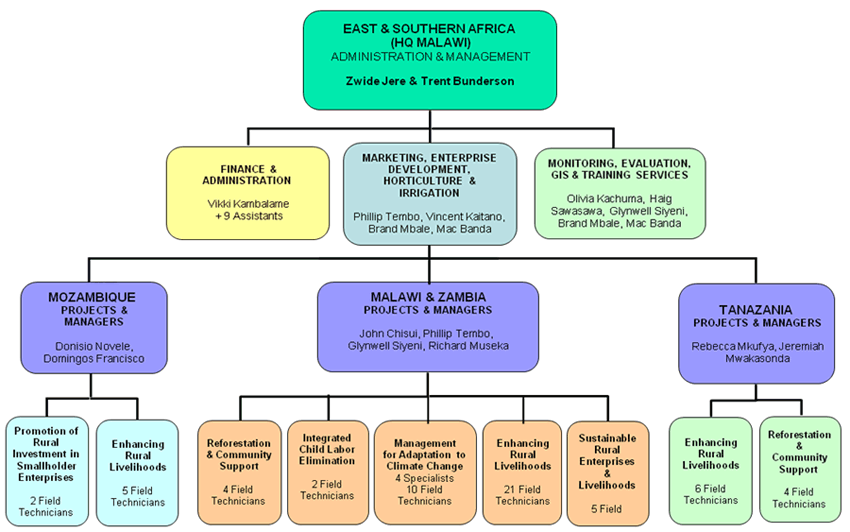
The HR function is quite versatile, which is why coining criteria for its evaluation may turn out to be quite difficult. Therefore, when selecting the criteria for the assessment of its function, one should consider focusing on the multiple aspects that shape it and define its efficacy. In the context of an organization, the tools such as benchmarking and key performance indicators (KPIs) can be quite helpful in embracing the complexity of the HR function and provide an accurate assessment of it. Namely, the specified strategies will allow examining the effectiveness of implementing two of the aspects of the HR function that are typically deemed as critical. These are the tasks of recruiting and training and development.
The concept of hiring can be defined as the process of looking for a candidate that meets the company’s criteria for a particular position in it best. In addition to the searching stage, hiring also involves selecting the appropriate candidates, interviewing them, and offering the [position to those that pass the requirements.
Additionally, when considering the existing options for hiring staff members, an HR manager may need to take other factors such as the number of employees and the number of jobs that an organization can create into account. Moreover, the specified function suggests controlling the hiring process and determining whether the succession plan is being implemented (Simons et al., 2016).
Furthermore, when evaluating the HR function, one will have to consider the criterion such as training and development. The identified aspect of a company’s performance is critical to its HR function since it shows how effective the company’s approach toward managing its HR and their talents is. The training and development task involves not only providing opportunities for gaining new competencies to employees but also ensuring that staff members train the skills that are useful to them as company member and that they can use to improve their work. Therefore, T&D is a crucial aspect of the HR function to be considered.
Internal Benchmarking
The concept of benchmarking is typically defined as the assessment of practices and strategies used in a particular company to those accepted in other successful organizations or even the best practices that can be observed in the selected area of business. Since the implementation of the HR function may lead to quite different results due to the differences in companies’ sizes, environments, and the extent of the staff’s knowledgeability and competence, the implementation of the HR function may vary to a great extent across the industry.
Therefore, the use of the homogenous assessment standards is needed, which is why the application of internal benchmarking is critical. Internal benchmarking allows evaluating the current level of performance within a company or a team in comparison to the standards set by other organizations in the field. Thus, the bar for good performance is set, and the target company’s ability to meet the provided criteria is assessed (Reilly, 2018). In the context of AT&T, internal benchmarking is used to determine the high-quality practices and implement them accordingly in the context of the organization, with its unique climate in mind.
KPIs
Key Performance Indicators (KPIs) have become a rather common tool for assessing corporate performance recently. The subject matter is usually defined as the set of standards that help employees to evaluate how closely they meet the company’s requirements for high-quality performance. Moreover, the main purpose of KPIs is to boost the levels and quality of employees’ performance to the desirable level. As a rule, in order to work effectively in a corporate context, KPIs include specific goals aligned with the company’s ones, a certain object at which the KPIs are directed, and the focus on Business Intelligence.
Allowing one to define whether the corporate objectives are met properly or not, KPIs can be controlled with the help of a systemized dashboard (Maka & Suresh, 2019). The latter offers crucial information on the set goals, the current level of their completion, and the areas on which a company will need to focus on order to improve its performance.
The application of proper HR practices is inextricably linked to the changes in organizational outcomes due to the impact that the HR function produces on the level of employees’ performance. Therefore, it is logical to expect that positive organizational outcomes will be tied directly to the effective HR practices. A recent study by Choi and Yoon (2015) supports the specified assumption, proving that the extent to which the HR practice is linked to substantiated evidence and research defines organizational outcomes.
Namely, the article asserts that high-involvement work practices used by HR managers contribute to building premises for improvements in organizational outcomes (see Fig. 20). The authors of the article hypothesize that union strategic participation makes the HR function more effective as the tool for amplifying organizational performance and contributing to the rise of a competitive advantage in an organization.
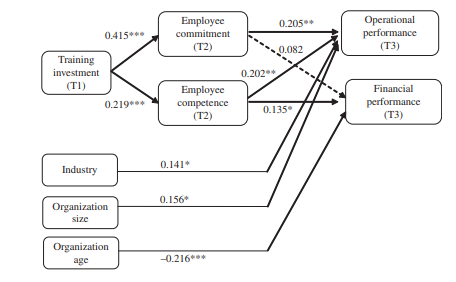
In the course of the analysis, the authors prove that their initial hypothesis was correct. With the help of the quantitative analysis, namely, the use of descriptive statistics, the authors assert that there is a connection between the rise in the efficacy of the HR function and the introduction of high-involvement union participation. The multiple evidence also indicates that there is a need to utilize pay-for-performance programs as a means of incentivizing employees to perform better and focus on meeting organizational objectives.
The article can be characterized by high levels of reliability. The evidence used in the study was obtained with the help of the Workplace Panel Survey (WPS) tool, which can be considered a reliable method for gathering data. In addition, the internal validity of the research is quite high since the authors have established a very clear logical connection between the main variables of their study.
Specifically, the research results prove that the integration of strategic HR functions into the organizational context lads to increased motivation, hence the improved performance and the rise in the company’s competitive advantage. Overall, the internal validity of the paper can be deemed as quite high. The same can be said about the external validity of the research given the fact that the outcomes of the analysis have been generalized well enough to be applied to any other environment.
Finally, the research is quite persuasive in its outcomes and the argumentation included in the discussion and conclusion. Due to the unambiguous outcomes of the analysis and the fact that the correlation between the two variables has been proven, the authors place quite a substantial emphasis on the correctness and veracity of their findings.
High-performance working (HPW) has been seen as an important objective for companies to strive toward since it implies increased productivity and high competitive advantage. Therefore, the role that HPW plays in shaping a company’s organizational practice is quite significant. Likewise, investing in the development of the human capital, namely, giving employees the opportunity to master new skills, gain new knowledge, and improve their performance, will lead to better organizational practice.
The article by Choi and Yoon (2015) clearly supports the idea of investing in the promotion of HPW as the corporate. Although the necessity to invest in the human capital is not expressed in the article explicitly, it is heavily implied that the HR function involves talent management and the provision of additional opportunities for staff’s professional development. For instance, the authors assert that “when HR functions are integrated into a firm’s strategic management, the firm should provide employees with career development opportunities to ensure that they possess competencies aligned with a firm’s strategies” (Choi and Yoon, 2015, p. 108).
With the increase in opportunities for becoming more proficient in their area, as well as exploring new ones, employees will feel more confident and effective at their job. In addition, their loyalty rates will soar since the described HR policy will imply that the company appreciates its staff and is willing to support it. Therefore, organizational success and performance depend fully on the company’s employees, who need opportunities for professional growth, hence the significance of HPW and investment in human capital.
Reference List
Álvarez Pérez, C., Rodríguez Montequín, V., Ortega Fernández, F., & Villanueva Balsera, J. (2017) ‘Integrating analytic hierarchy process (AHP) and balanced scorecard (BSC) framework for sustainable business in a software factory in the financial sector’, Sustainability, 9(4), pp. 486-502.
Banfield, P., Kay, R. and Royles, D. (2018) Introduction to human resource management. Oxford, UK: Oxford University Press.
“Could AT&T, Inc. Be a Millionaire-Maker Stock?”. (2018). Web.
Choi, M. and Yoon, H. J. (2015) ‘Training investment and organizational outcomes: A moderated mediation model of employee outcomes and strategic orientation of the HR function.’ The International Journal of Human Resource Management, 26(20), pp. 2632-2651.
Konradt, U., Garbers, Y., Böge, M., Erdogan, B., & Bauer, T. N. (2017) ‘Antecedents and Consequences of Fairness Perceptions in Personnel Selection: A 3-Year Longitudinal Study’, Group & Organization Management, vol. 42, no. 1, pp. 113-146.
Maka, B., & Suresh, N. (2019) ‘Development of a Quantitative Model to Integrate the Network KPIs and Commercial KPIs to Evaluate the Financial Performance of MTN Ghana’, International Journal of Applied Engineering Research, 14(6), pp. 1334-1339.
Nadda, V., Rafiq, Z., & Tyagi, P. (2017) ‘Effectiveness and challenges of recruitment process outsourcing (RPO) in the Indian hotel sector’, International Journal of Academic Research in Business and Social Sciences, 7(2), pp. 218-236.
Parker, S. (2015). Top HR influencers social recruiting stats and mobile recruiting with a side of guac. Web.
Reilly, P. (2018) The impact of Artificial Intelligence on the HR function. New York, NY: Routledge.
Simons, J. P., Goodney, P. P., Flahive, J., Hoel, A. W., Hallett, J. W., Kraiss, L. W.,… & Society for Vascular Surgery Vascular Quality Initiative. (2016) ‘A comparative evaluation of risk-adjustment models for benchmarking amputation-free survival after lower extremity bypass’, Journal of Vascular Surgery, 63(4), 990-997.
‘Worldwide spending in the recruitment process outsourcing industry from 2017 to 2022 (in billion U.S. dollars)*.’ (2020). Web.
